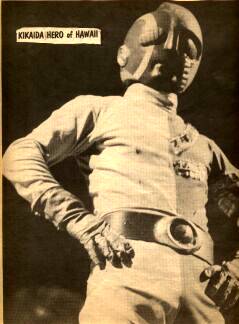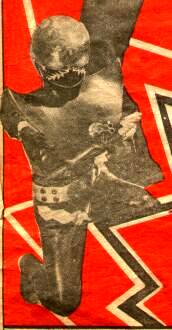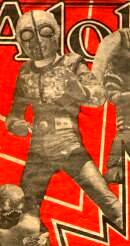

(photos from Star-Bulletin & Advertiser, 1974)


(photos from
Star-Bulletin & Advertiser, 1974)
Kikaider,
television's popular mechanical man, will be in town to perform at the
50th State Fair during the Labor Day weekend. Arrangements to bring the
seven-man troupe to Honolulu were made through KIKU-TV, and the
Honolulu Jaycees are sponsoring the "Kikaider" act complete with
monsters and androids, which is put on at parks and recreation centers
throughout Japan. The Honolulu Jaycess have arranged for a local
showing.
Science fiction and monster TV
movies are popular among Japan's youngsters, and the Hawaii appearance
marks a "first" for Japanese monster characters. Last minute plans
include transporting the life-sizes costumes (highly valued) and
rewriting the script into English.
The "Kikaider" series on
Channel 13 has been running for 26 weeks, and will continue for another
17. The plot is basically the same each week.
Jiro,
the main character (actually "Kikaider" the mechanical man), was
created by Dr. Komyoji. Kikaider has a conscience circuit to combat the
evil monsters and androids. He changes from his human form into
Kikaider and performs miraculous feats; never failing to destroy the
monsters in the end. Although the plot is simple, youngsters are
attracted to the series because each episode is filled with Japanese
creativity and skillful camera techniques. Also the cast is headed by a
handsome young man, Jiro. Dr. Komoyoji's daughter, Mitsuko is in love
with him although it depresses her that in reality, he is a mechanical
man. Komoyoji's son Masaru too, encounters danger every week.
Professor Gill, head of the
Dark Demolition Corps, is symbolized by the sound of an evil flute.
Jiro's conscience circuit resists the flute and he is immediatly
transformed into Kikaider.
Kikaider is not the most recent
of similar monster films in Japan (it is now being re-run in Tokyo).
But because it was a first here in Hawaii, the response was
overwhelming. Local merchants have been extremely busy trying to locate
the dated Kikaider products in Japan.
The original Kikaider will be
at the 50th State Fair along with Hakaider
(translated 'Destroyer'), 2 androids and 3 monsters. Because of the
weight and size of the costumes, performances under the warm Hawaiian
sun are not the most ideal setting for the Kikaider Show, so all
performances have been scheduled during the evening.
Local youngsters will finally
get to meet their favorite TV hero in person; and at the same time the
producers of the show, accompaning the troupe from Japan, will realize
Kikaiders popularity in the Islands.
-- article from
Star-Bulletin & Advertiser, 1974, before the first live
Kikaider Show in Hawaii

(photo from
Star-Bulletin & Advertiser, 1974)
New TV Heroes Conquer
Monsters
By Phil Mayer, Star-Bulletin Writer
RAINBOW
MAN is seven different good guys, one for each day of the week.
He can change identities
because he is also mild-mannered Yamoto Takeshi, a college student who
studied under a guru in India.
When he must outwit the no-good
"Mr K" and his "Shine-Shine" gang, Takeshi can become Moon Man, Fire
Man, Water Man, Leaf (or Tree) Man, Gold Man, Ground (or Earth) Man and
Dash 7, who is also known as "Rainbow Man".
...Eat your heart out Clark
Kent.
There are 19 more original
"Kikaider" episodes and 28 more original "Rainbow Man" episodes to be
shown Saturdays at 8 and 8:30 p.m. respectively.
Reruns, beginning with the
first episodes, started nine weeks ago at 7 p.m. and 7:30 p.m.
Wednesdays.
Fans of both series can see a
total of four different shows each week, which also makes several
stores happy.
One reportedly sold about
$4,000-worth of "Kikaider" and "Rainbow Man" things in a single weekend
and reservations are required for such items as Rainbow Man dolls.
The price per doll recently
went up from $2.95 to $3.95, which increases the cost of a set of seven
from $20.75 to $27.65 in most stores that stock the Barbie Doll-sized
figures.
One of the four major
Kikaider-Rainbow Man outlets in Honolulu has opened several mornings
with lines of shoppers waiting for air-freighted goods which have only
been on the ground a few hours.
BUT
THE STORY of how the "Kikaider" episodes were and continue to be
subtitled is more remarkable.
Teru Otsuka, formerly a newsman
at the Japanese language raido station, KZOO, and his wife lived not
far from the KIKU office.
Each week they came to the
station to watch and listen to the Japanese soundtrack which Miyori
transcribed word-for-word.
Her transcription then was
translated into English by Ikuo Ichida, a graduate assistant at the
University of Hawaii.
Then his work was gone over by
Betty Santoki of the KIKU staff, who reworked the translation into
subtitles of no more than two lines of 24 letters and spaces per film
frame.
Then the Otsukas moved back to
Hokkaido. So now a tape recording of each week's Japanese sound track
is sent to them from KIKU to which it returns as a transcript to be
made into subtitles.
Alvin Hamada of the KIKU staff
was assigned to make subtitles for "Rainbow Man" after 26 episodes had
been shown without them.
And -- Gloriosky, Godzilla --
the newspapers are already beginning to advertise "Gatcha Man" and
"Ultra Man" dolls.
-- article from
Star-Bulletin & Advertiser 1974
Besides Rainbowman, KIKU has
been running another science fiction series called "Kikaider" the same
evenings. "Kikai" meaning "machine" in Japanese symbolizes Kikaider the
hero of this action-filled science fiction. Dr. Komyoji, working for
the evil Professor Gill, originally built a mechanical man able to
perform spectacular feats. This mechanical man is disguised in the
normal being of Jiro, a roving guitarist.
The villain of this story,
Prof. Gill of the Planet Dark, tries to get Kikaider back and to use
him for evil purposes. The power Gill has over Kikaider is his powerful
flute. If Jiro succumbs to the flute, he becomes a follower of the
Dark. The incomplete conscience circuit in Jiro resists Gill's flute.
Meanwhile Professor Gill creates different monsters and encourages his
Dark Corps to try to conquer Jiro, Dr. Komyoji, and his children.
Why do kids watch these two
modern adventure series? Perhaps because they're different. Obviously,
the nationalities of the characters and spoken language are unique, but
never before have such imaginative monsters appeared on local tv
screens. The villains are abominable in character. A young cast
portrays the characters; and major supporting roles are played by
children about the age of the average viewer. Thus youngsters associate
with the strong and let their imaginations run wild weekly. The plots
of both Rainbowman and Kikaider are simple. Both heroes must combat an
evil organization. When the crucial moment comes, both change from
human forms to that of the super hero.
-- excerpt from article
from Star-Bulletin & Advertiser 197?

(photo from
Star-Bulletin & Advertiser, 1974)
Kikaider-01, who will make personal appearances with Hakaider and other monsters and andriods at Honolulu International Center's Exhibition Hall this week, is the oldest of three robot brothers created by Doctor Komyoji. In the TV series, Kikaider-01 awakens after three years of dormancy inside the statue, "Niyoo No Kami". Doctor Komyoji had set Kikaider-01's computer to function when terror plagued the people of Japan.
Kikaider-01, is humanized in the form of Ichiro (or first son), Kikaider as Jiro, the second son and Hakaider as Saburo, the third Son.
Although Kikaider-01 and Kikaider are robots combating evil, ironically Hakaider, their youngest brother turns out to be evil. The reason for this fate is that Doctor Komyoji created Kikaider-01 and Kikaider voluntarily to eradicate the wicked and to maintain peace and harmony in Japan. Hakaider on the otherhand, was created by Doctor Komyoji forcefully with Professor Gill's command. Hakaider appears with three other powerful partners, Blue Hakaider, Red Hakaider, and Silver Hakaider to terrorize the people of Japan and to destroy his brothers.
Hakaider, like Professor Gill, holds the flute that weakens Kikaider in the new series. Although Kikaider-01 is not affected by the flute, he too has a weakness. His robot power is derived from solar energy, and without sun his power is extinguised.
The Kikaider troupe that appeared live at the 50th State Fair could not get over their unsung popularity in Hawaii. In Japan, they take the parts of bad samurai who get killed. Kikuchi Toshiaki (the actor in Kikaider's costume) was an overnight hero here and swamped for autographs wherever he went.
KIKU started the new Kikaider-01 series last Saturday night on channel 13.
Kikaider,
Kikaider-01, Hakaider, Jiro (actor Ban Daisuke), six monsters and
androids will be here for a special New Year's peformance at the HIC
Exhibition Hall, January 1 - 5. Three shows daily on January 1 and 2,
and four shows daily on January 3, 4, 5.
-- article from
Star-Bulletin & Advertiser, Dec. 1974, before the second live
Kikaider Show in Hawaii
In 1974 during the 50th State Fair 30,000+ enjoyed a Kikaida stage show (10 shows over
3 days).
![]()